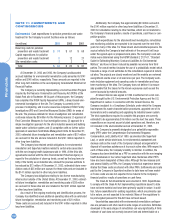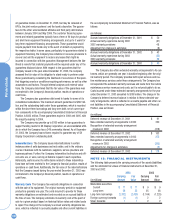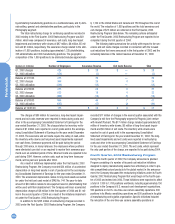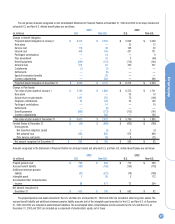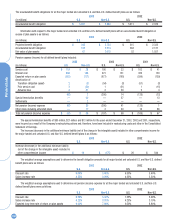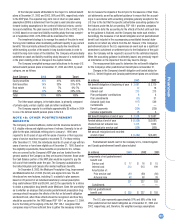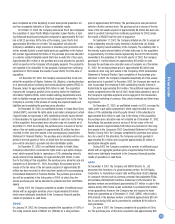Kodak 2003 Annual Report Download - page 66
Download and view the complete annual report
Please find page 66 of the 2003 Kodak annual report below. You can navigate through the pages in the report by either clicking on the pages listed below, or by using the keyword search tool below to find specific information within the annual report.
Financials
66
Consolidated Statement of Earnings for the year ended December 31,
2003. The completion of the 2001 Restructuring Programs resulted in the
elimination of the remaining 200 positions included in the original plans.
A total of 6,425 positions were eliminated under the 2001 Restructuring
Programs.
The remaining severance reserve of $6 million as of December 31,
2003 has not been paid since, in many instances, the employees whose
positions were eliminated could elect or were required to receive their
severance payments over an extended period of time. However, these pay-
ments will be made by the end of 2004. Most of the remaining exit costs
reserves of $13 million as of December 31, 2003 represent long-term
lease payments, which will be paid over periods after 2004.
NOTE 17: RETIREMENT PLANS
Substantially all U.S. employees are covered by a noncontributory defined
benefit plan, the Kodak Retirement Income Plan (KRIP), which is funded by
Company contributions to an irrevocable trust fund. The funding policy for
KRIP is to contribute amounts sufficient to meet minimum funding require-
ments as determined by employee benefit and tax laws plus additional
amounts the Company determines to be appropriate. Generally, benefits
are based on a formula recognizing length of service and final average
earnings. Assets in the fund are held for the sole benefit of participating
employees and retirees. The assets of the trust fund are comprised of cor-
porate equity and debt securities, U.S. government securities, partnership
and joint venture investments, interests in pooled funds, and various types
of interest rate, foreign currency and equity market financial instruments.
At December 31, 2001, Kodak common stock represented approximately
3.4% of trust assets. In December 2002, in connection with Wilshire
Associates’ recommendation that KRIP eliminate its investments in spe-
cialty sector U.S. equities, the Company purchased the 7.4 million shares
of Kodak common stock held by KRIP for $260 million.
On March 25, 1999, the Company amended this plan to include a
separate cash balance formula for all U.S. employees hired after February
1999. All U.S. employees hired prior to that date were granted the option
to choose the KRIP plan or the Cash Balance Plus plan. Written elections
were made by employees in 1999, and were effective January 1, 2000.
The Cash Balance Plus plan credits employees’ accounts with an amount
equal to 4% of their pay, plus interest based on the 30-year treasury bond
rate. In addition, for employees participating in this plan and the
Company’s defined contribution plan, the Savings and Investment Plan
(SIP), the Company will match SIP contributions for an amount up to 3% of
pay, for employee contributions of up to 5% of pay. Company contributions
to SIP were $15 million, $14 million and $15 million for 2003, 2002 and
2001, respectively. As a result of employee elections to the Cash Balance
Plus plan, the reductions in future pension expense will be almost entirely
offset by the cost of matching employee contributions to SIP. The impact
of the Cash Balance Plus plan is shown as a plan amendment.
The Company also sponsors unfunded defined benefit plans for cer-
tain U.S. employees, primarily executives. The benefits of these plans are
obtained by applying KRIP provisions to all compensation, including
amounts being deferred, and without regard to the legislated qualified
plan maximums, reduced by benefits under KRIP.
Most subsidiaries and branches operating outside the U.S. have
defined benefit retirement plans covering substantially all employees.
Contributions by the Company for these plans are typically deposited
under government or other fiduciary-type arrangements. Retirement bene-
fits are generally based on contractual agreements that provide for benefit
formulas using years of service and/or compensation prior to retirement.
The actuarial assumptions used for these plans reflect the diverse eco-
nomic environments within the various countries in which the Company
operates.
The measurement date used to determine the pension obligation for
all major funded and unfunded U.S. and Non-U.S. defined benefit plans
comprising a majority of the plan assets and benefit obligations is
December 31.


